If you have a tile floor, you know it’s important to keep it in good condition. Unfortunately, loose tiles are one of the most common problems with tile floors. Fortunately, there are several ways to fix a loose tile floor.
In this blog post, we will discuss a few methods how to fix a loose tile floor. We will also provide tips on preventing this problem from occurring again. So, if you are experiencing problems with your tile floor, read this blog post!
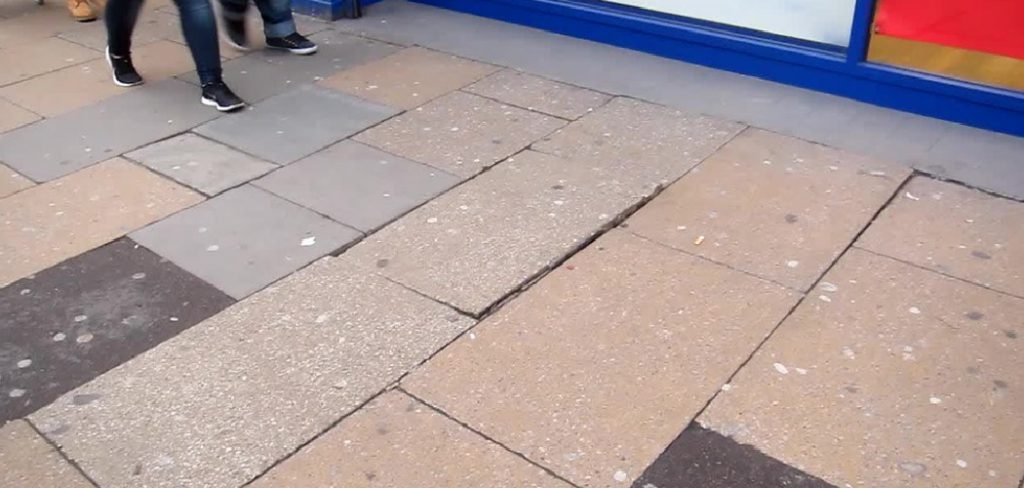
10 Common Reasons That Causes a Loose Tile Floor
1. Not Enough Mortar Was Used:
It is important to use the right amount of mortar when installing a new tile floor. This is because if you do not use enough mortar, the tiles will not be properly secured and could become loose over time. To make sure you use the right amount of mortar, you should follow the manufacturer’s instructions carefully.
2. The Mortar Was Not Mixed Properly:
One of the most common reasons for a loose tile floor is improper mortar mixing. If the mortar isn’t mixed correctly, the tiles won’t adhere to the floor and eventually the floor will become loose. To fix this problem, you’ll need to remove all loose tiles and mix a new batch of mortar. When mixing mortar, always check the package instructions to ensure you’re doing it correctly.
3. The Tile installation Was Done in Humid Conditions:
When you are installing a new tile floor, it is important to use the right amount of mortar. This is because if you do not use enough mortar, the tiles will not be properly secured and could become loose over time. To make sure you use the right amount of mortar, you should follow the manufacturer’s instructions carefully.
4. The Grout Joints Are Too Wide:
A common problem that can lead to loose tiles is when the grout joints are too wide. This provides an opportunity for the tiles to shift and become loose. To fix this problem, you will need to remove the old grout and install new grout with joints that are the proper width. Another common problem that can cause loose tiles is an uneven floor. This means the floor is not level and can lead to the tiles shifting and becoming loose. To fix this problem, you will need to level the floor.
5. The Grout Was Not Properly Mixed:
One of the most common reasons for a loose tile floor is improper mortar mixing. If the mortar isn’t mixed correctly, the tiles won’t adhere to the floor and eventually the floor will become loose. To fix this problem, you’ll need to remove all loose tiles and mix a new batch of mortar. When mixing mortar, always check the package instructions to ensure you’re doing it correctly.
6. The Tile Was Not Sealed:
If the tile was not sealed, moisture can seep into the pores and cause it to loosen and fall off the floor. To fix this problem, you must reseal the tile with a quality sealer. Before sealing the tile, clean it thoroughly with a tile cleaner or mild soap and water. Once the tile is clean and dry, apply the sealer according to the manufacturer’s instructions.
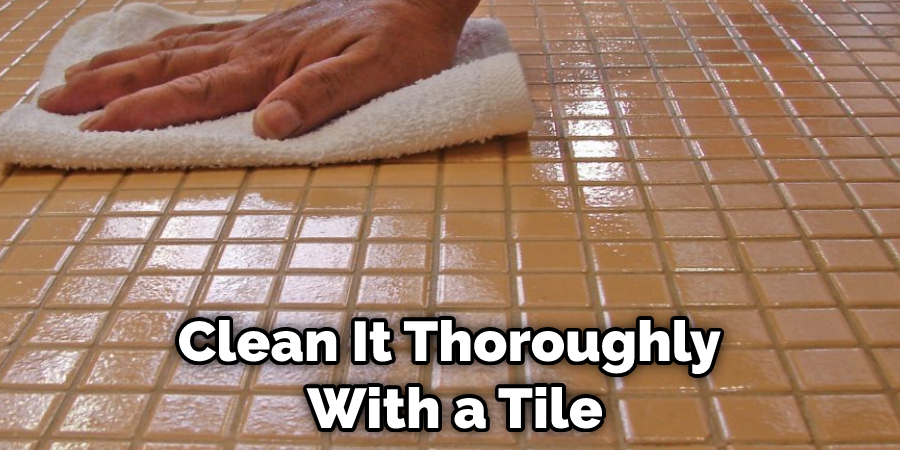
7. The Subfloor Was Not Prepared Properly:
If the subfloor was not prepared properly, it can cause the tile to become loose. The subfloor needs to be cleaned, leveled and dry before installing the tile. If the subfloor was not prepared properly, it could cause the tile to become loose and eventually fall off. Make sure that, if you are having tile installed, the subfloor is prepared properly to avoid this issue.
8. The Wrong Type of Adhesive Was Used:
If the wrong type of adhesive is used, it can cause the tile to become loose and eventually fall off. Make sure to consult a professional to find out what type of adhesive should be used for your tile and subfloor.
9. The Tile Was Cut Incorrectly:
If the tile was cut incorrectly, it could cause it to become loose and fall off. When cutting tile, always use a sharp blade and ensure the cuts are straight. If the tile was cut incorrectly, it will need to be replaced. To make sure the tile is cut correctly, use a level and a straight edge when cutting. Always check the tile before installing it to ensure it is level.
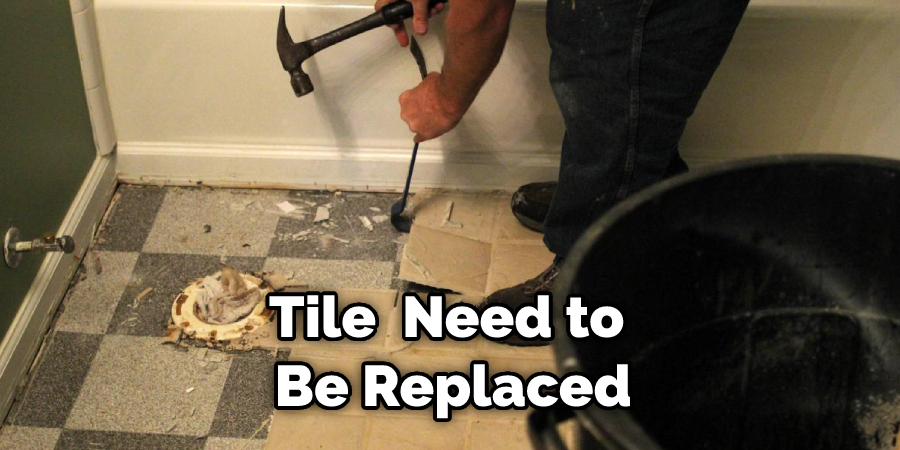
10. The Subfloor Is Too Soft:
If the layer beneath your tile flooring is too soft, your tiles may eventually become loose and fall off. The subfloor needs to be firm and sturdy to support the tile. If the subfloor is too soft, you may need to replace it. Be sure to consult with a professional to find out what type of subfloor is best for your home. Always check the warranty of your tile before making any changes to the subfloor.
7 Effective Methods on How to Fix a Loose Tile Floor
1. Use Adhesive Tape to Secure the Tile:
If the tile is only slightly loose, you can try to secure it with adhesive tape. This quick and easy fix will usually hold the tile in place until you can get a more permanent solution. Just be sure to use a strong tape that won’t come loose easily. If the tile is very loose, this probably won’t work, though.
2. Use Construction Adhesive to Reattach the Tile:
If the tile is loose but still intact, you can try using construction adhesive to reattach it. This is a stronger solution than tape, but it will still be temporary. First, you’ll need to clean the area around the loose tile and then apply the adhesive with a caulk gun. Press the tile firmly and hold it there for a few minutes while the adhesive dries.
3. Pry Up the Tile With a Putty Knife:
If the tile is broken or has come completely loose, you’ll need to pry it up with a putty knife. Be careful not to damage the surrounding tiles as you do this. Once the tile is removed, clean up any adhesive that may be left behind and then proceed to one of the other methods to reattach the tile.
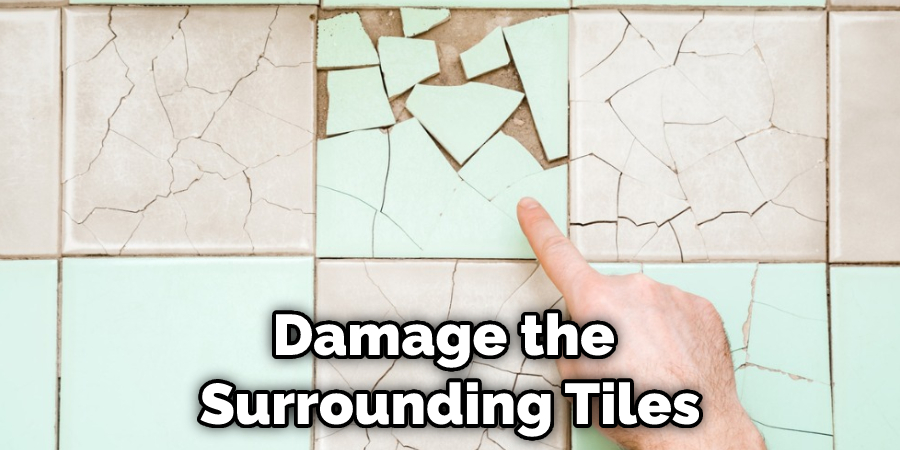
4. Use an Adhesive to Reattach the Tile:
If the tile is still intact and just loose, you can use an adhesive to reattach it. First, clean both the tile and the area around it. Then apply a thin layer of adhesive to both the tile and the floor. Next, place the tile back in its original spot and press it down firmly. You may need to hold it in place for a few minutes while the adhesive dries.
5. Replace Damaged Tiles:
If the tile is cracked or broken, you will need to replace it entirely. First, remove the grout around the damaged tile with a grout saw or other tool. Next, use a chisel to remove the tile itself. Again, be careful not to damage the surrounding tiles. Finally, install a new tile in the space. When replacing the damaged tile, be sure to use the same tile so that it blends in with the rest of the floor.
6. Re-Grout the Floor:
Once all loose tiles have been repaired or replaced, you will need to re-grout the entire floor. First, mix the grout according to the manufacturer’s instructions. Next, apply the grout to the joints between the tiles using a grout float. Next, work the grout into the joints, filling them. Finally, use a damp sponge to remove any excess grout from the surface of the tiles. Allow the grout to dry for at least 24 hours before walking on the floor.
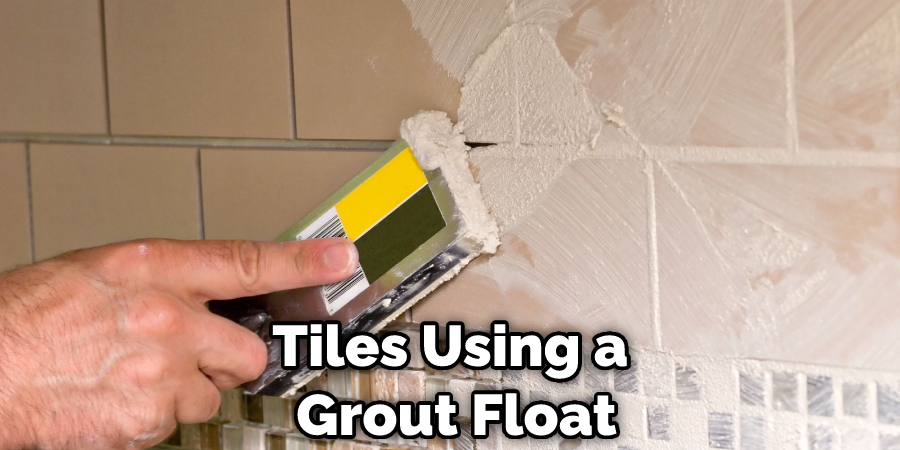
7. Seal the Floor:
Once the grout has completely dried, you will need to seal it. This will help protect the grout from dirt and stains. Apply the sealer with a brush or roller, and get into all the cracks and crevices. Let the sealer dry completely before walking on the floor. If you think the floor may be subject to a lot of wear and tear, you may want to apply a second coat of sealer.
You Can Check It Out to How to Fix Hydrostatic Pressure on Basement Floor
Frequently Asked Questions
What Causes Floor Tiles to Become Loose?
Floors are the foundation of any home, and as such, they play a very important role in supporting the building. However, over time, Floors can become loose and vibrate which can cause structural damage to your home. There are many factors that contribute to this phenomenon including age, heavy use/motion throughout the day or week, water infiltration due to faulty drainage systems or walls, etc. poor construction techniques used during installation, etc. climate fluctuations (e.g.: warmer temperatures causing expansion and contraction), insufficient maintenance (e.g.: improper cleaning routines or neglecting caulking jobs), storage of large items on top of floor tiles, etc.
If you’re noticing cracks in your floor tiles or it seems like they’re moving around easily from footstep to footstep – then it’s probably time for a checkup by an experienced contractor! In most cases where Floors have become loose – there is usually some underlying problem that needs fixing before anything severe happens.
Will Grout Hold a Loose Tile?
Yes, grout will hold a loose tile. However, if the tile is severely damaged or has been dislodged from its mortar joint then it may not be possible to secure it with grout. In these cases, you may need to replace the Tile and Re-mortar the Joint.
What is the Best Glue for Tiles?
There are a lot of different types of glue that can be used for tiles, but the best glue for tiles is probably either silicone or hot melt adhesive. They both work well and have a variety of applications. Here are a few more details on each:
- Silicone glue is great for attaching tiles to other tiles, grout, and masonry. It’s also good for attaching paper to wood or other surfaces.
- Hot melt adhesive is perfect for attaching tiles to other surfaces like wood, brick, or concrete. It’s also good for attaching paper to other surfaces.
- Both silicone and hot melt adhesives are safe to use in high-traffic areas and can last for several days without fading or peeling
Do You Fix a Loose Floor Tile Without Removing It?
If you’re unable to fix a loose floor tile without removing it, then you should call an expert. This is because the weight of the tile and its placement on the floor can cause permanent damage if left unchecked. A professional will be able to remove the damaged tile and replace it with a new one that is firmly in place.
If this isn’t possible or your timeline is short-term, then you may need to resort to temporary fixes such as taping or bracing tiles in position until a replacement Tile arrives. In either case, ensure that everything is tightly secured in order to prevent further wobbling and instability.
Why Does It Sound Hollow Under My Tile?
There are a few potential causes for this issue, and they can usually be solved by following a few simple steps.
If the ceiling is framed with drywall, then there may be gaps between the boards that allow sound to travel through the wall. You can fix this problem by inserting acoustic caulk into these gaps or using foam insulation to fill in any voids. If your ceilings are built with sheetrock or another type of construction material, you will need to install special soundproofing materials in order to reduce noise levels.
If you cannot identify the source of the noise, your only option may be to have an expert evaluate and seal the entire ceiling surface. This job can often cost hundreds of dollars, but it could save you from having noisy walls that ruin your quality of life.
You Can Check It Out To Fix Loose Tile in Kitchen
Final Words
If your tile floor is loose, there are a few ways to fix it. Depending on the problem’s bad, you may need to remove and replace some of the tiles or use an adhesive to fix them. No matter which method you choose, seal the grout so it doesn’t become loose again.
By following these simple steps on how to fix a loose tile floor, you can restore your tile floor to its original condition and enjoy years of beautiful floors. Have you ever had to fix a loose tile floor? What method did you use? Let us know your thoughts in the comments below!
